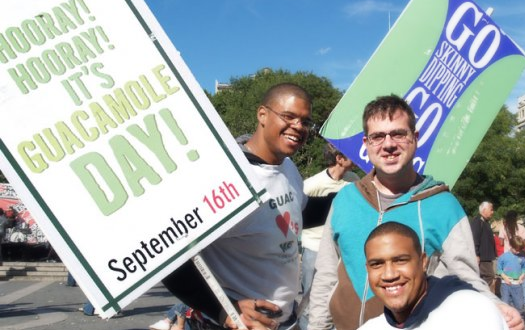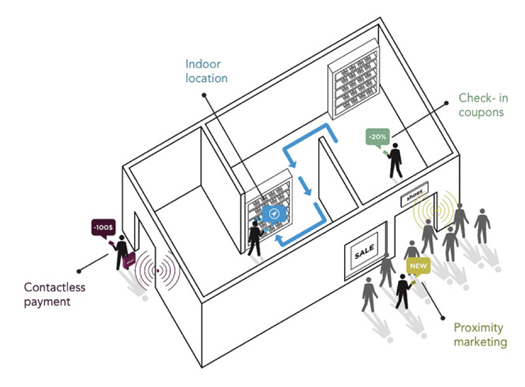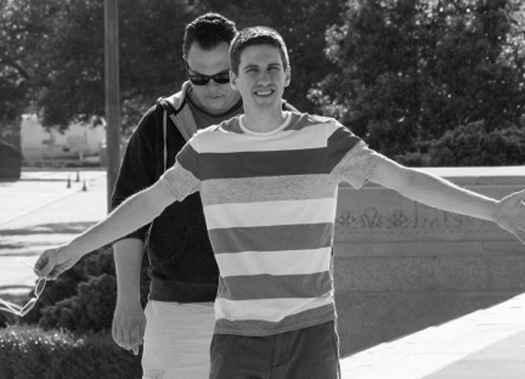By
Team DIGO | 05/22/2014 | in

Marc Lefton, Growth Strategy and Brand Integration at DiMassimo Goldstein
When I started 9th grade, my first venture into graphic design was an ill-fated attempt to create my own report card. I did not succeed – part of my punishment was helping my mom around the ad agency she worked for during my school vacations. I discovered the creative department, where I put my self-taught graphic design skills to more productive use: making advertisements. I was immediately hooked. I found what I wanted to do for a living and never looked back. I loved advertising. Seeing something I worked on yesterday in the paper today was exhilarating.
The next few years were a whirlwind. Skipping college, I bounced around a few small places on Long Island before I reconnected with the art director who had taken the time to mentor me. He told me I should be an “ad creative.” I had no idea what that was. I visited his new job at seminal NYC ad creative shop of the 90s, Mad Dogs and Englishmen. There I learned that there was a job beyond just laying out ads: people came up with crazy, funny, exciting ideas as well. And they got paid for it!
When I was just 20, I was already working at one of the largest agencies in the world – BBDO, helping work on Super Bowl Commercials for brands like Pepsi and Visa. I spent my early 20s at big agencies in NYC before moving to Massachusetts. At the end of the two years I spent up there, I saw a drastic shift happening towards digital and the beginnings of social media. Realizing things were changing faster than anyone could keep up, and always trying to learn what’s next, I immersed myself in everything new and different. To that end, I started one of the first business social networks ever, Adholes.com, which for some advertising people in 2004, was the first social network they ever experienced.
Upon returning to New York, I still sought the safety of getting a job doing traditional advertising. I still liked the idea of writing a funny commercial or headline for a print ad. I wanted to switch to being a writer full-time and started to shop my portfolio around. I got Mark DiMassimo to meet with me. He looked at my portfolio and said “You’re a good enough writer, and I could hire you to do that – but everything you’re doing with social media and experiential is really exciting – you should go pursue that.” (more…)
By
Team DIGO | 05/20/2014 | in
Apple. Virgin. Southwest. JetBlue. Crunch. Snapple. Groupon. BlueFly. Zappos. The Motley Fool – what do these brands have in common? They’re challengers, and successful ones at that.
They’ve mastered the art of zagging where others tend to zig. They’ve taken on the goliaths in their industries and have come out on top. The truth is, it’s a tough world out there, and every marketer these days needs to be a successful challenger or go down trying.
Market leadership doesn’t create an exception. Look at Citibank and IBM. By becoming their own best competition, they look like ready challengers, reinventing their businesses and continuing to grow.
Here’s what challengers do differently:
The top dog is INVOLVED – intimately.
Some folks think the reason they got degrees and big titles was to independently run their own empire. Some of these people are actually pretty smart; but nine times out of ten, this attitude does them in.
A boss is not a meddler to be avoided. If you were playing chess, you wouldn’t leave your queen in the background and try to fight it out endlessly with your lesser pieces. Or would you? (more…)
By
Team DIGO | 05/16/2014 | in
The difference between loving what you do and being stuck in a dreary work situation is taking a hard look at the things around us that we accept and take for granted. The enthusiasm that drives those leaps to greatness starts with questioning why we’re even doing what we’re doing in the first place. We have to ask, “is this working?” for everything. Yet when we become complacent and accept things without thought, we head first into lazy-minded traps that make us fall out of love with what originally drove us.
Maybe there are too many “yes” people around. Perhaps the fear of questioning what is “working” or “good enough” is overwhelming the love it takes to push to the next level.
This attitude manifests itself regularly in marketing departments and ad agencies. Mediocre results and incremental gains are sometimes the only success people know. If they’re not inspired by what a leap to greatness can do for their brand, they will continue to accept the pedestrian–the “just good enough.” But that’s, well, just not good enough.
There’s a joke about five monkeys in a cage. A bunch of bananas is hung high in the cage out of the reach with some boxes placed at the bottom. The monkeys pile the boxes, climb up, get the bananas, and are sprayed with cold water. One monkey is removed from the cage as he figures out the boxes and the rest of the monkeys beat him up. Eventually, no monkey in the cage is sprayed with cold water for reaching the bananas, but any time a new one enters, he is beaten for trying. Why? Because that’s how we always do things around here.
If you and your team–your agency, partners, and loved ones–are not constantly questioning, then there’s no opportunity to evolve, to reflect, and to learn. (more…)
By
Team DIGO | 05/14/2014 | in
Looking to learn and laugh on tomorrow morning’s commute? We’ve got you covered.
Agency Partner and Chief Creative Officer Tom Christmann recently joined Sean Grace and Nadia Blake on The Storyboard Podcast. The episode – a 38-minute adventure – is a beautiful combination of both industry knowledge and hilarity. Tune in as the three explore topics such as virtual reality, the future of advertising, the direct economy and much more. You may also find out that Tom is apparently a hologram who is “completely wasted” and “#blessed” (even though only one of those is actually true – we think).
Be sure to follow both Nice Shoes and Sound Lounge, who Co-Produce the Podcast, and be on the lookout for the next great episode!
By
Team DIGO | 05/08/2014 | in

iBeacon, Apple’s tiny Bluetooth-enabled device, is a disruptive technology set to allow brands to intercept shoppers at the exact point of intent. It’s bringing us even closer to an “internet of things” and will give us creative and opportunistic ways to engage the retail consumer. While our phones are currently smart enough to know how to run complex apps or contact servers across the globe, until now, the device doesn’t know if you’re in your kitchen, bedroom, frozen foods section or milk aisle.
With a range of 50 meters, inexpensive iBeacons can cover 2,500 square meters. This means that even an average Macy’s store at 16,258 square meters would only need 7 of them. Instead of simply knowing you’re near a store (as today’s location-based services do), iBeacons will know precisely which section you’re in, enabling retailers to send contextual messages accordingly.
Why would consumers want to accept such messages? Although it may be seen as intrusive, receiving a subtle text that you can choose to view or not is much easier than dealing with aggressive salespeople. Furthermore, people are likely to opt in if receiving a good value such as an instant deal. For a retailer, it can mean the difference between someone browsing and making a purchasing decision in real time.
The potential of this technology really starts to shine when you mash it together with a loyalty program enabling far more personalized offers. If someone were looking at a particular item for a long period of time, they might be prompted with videos and information of interest. There are rumors that Apple will offer an integrated payment system so consumers can purchase items as they walk through the store rather than bothering with lines and checkouts.
Jakub Krzych, CEO of Estimote, the startup behind iBeacon technology, estimates that reducing the friction at retail will have an economic impact “in the trillions.” With startups such as Uber allowing consumers to pay for cabs without cash or credit cards, it’s just a matter of time before this ability is implemented everywhere.
iBeacons is not just limited to retail. MLB just completed fitting Dodger Stadium and Petco Park with the devices, the first two of 20 that will use the technology by opening day of 2014. By using MLB Advanced Media’s At The Ballpark app, everything from preloading tickets at the gate to providing relevant in-game content will soon be possible.
At DiGo, we love discovering and learning new technologies for our clients, and we’re inspired to push the possibilities to the edge. Left unattended, an iBeacon’s with low energy use can emit data for up to three years. We believe it’s just a matter of time before “guerrilla” iBeacons pop up in dense urban locations, cleverly hidden in rival stores. Imagine the havoc competing car dealerships could have.
We see the possibility of adding the technology to outdoor billboards and pop up experiential events as a must-have of any integrated campaign. Forget about janky, ugly QR codes or convoluted “text to win” messaging. Now communications will pop up on phones automatically.
With the ability to cheaply cover the world in devices that emit location-oriented communications, the new marketing is about to shift from something a few consumers actively participate in to a state where messages are received passively with greater context than ever before. As always, it will be the smartest brands and growth leaders who leverage this technology—the faster and better.
By
Team DIGO | 05/07/2014 | in

Chris Erickson, Brand Supervisor
I moved to NYC from Minnesota 3 1/2 years ago on a whim. The only thing I was sure of at the time was that I wanted to work in marketing, and what better place to start than Manhattan? My desperate job hunt landed me at some random social media tech startup with two other people in a shared office space. On day one I received a call on my lunch break from DiMassimo Goldstein offering me an internship, and by 6pm on my first day as a full-time employee EVER I had quit my job to take a chance at a real NY ad agency.
The very next morning I was headed to yet another internship, but this one felt different. This was going to be the one that turns me into a real member of society…the type that has health insurance but can’t afford it. Starting out I did all the glorious and wonderful things that interns get to do, like use the company’s Flip Cam (R.I.P.) to record our Art Director and Designers’…..ping-pong matches.
After a couple months of filming and learning some actual Client Service skills I was hired full-time at an agency that declares themselves as a “Growth Agency Network” for their clients. In just 3 years, 7 desk changes, 1 TV show cameo, 214 late-night Seamless orders, mixed with a little bit of good timing, I’ve found myself in a position that would typically take someone at an “ordinary agency” twice as long to attain. That’s when I started to realize that this place is far from ordinary.
I really have to credit my rapid success to the names on the door and the people inside. It’s a testament to their 18-year-old Growth Agency Network and “Brand. Driven. Growth.” motto which doesn’t just pertain to their clients, but to their team that makes it all happen.
…Now We’re Here!
By
Team DIGO | 05/01/2014 | in

Laura Mueller, Jr. Digital Producer at DiMassimo Goldstein
Flash, HTML, CSS, JavaScript. These are just a few of the things that come up in my conversations every day. When I was hired as a Jr. Digital Producer, I had no idea that I had the ability in me to enable some crazy awesome developers to make magic.
With the extraordinary guidance of Cait DeAngelis, I learned, made mistakes, and re-learned. I quickly realized that this job was something you can only learn how to do by actually doing it. The nitty-gritty of it all- you just don’t learn that in ad school.
In my quest to absorb as much knowledge about the digital world as possible, I’ve enabled what I like to call “digital artists” who work with code to create some stellar products. Working closely with and watching these developers turn a layered PSD into a fully functioning website is beyond amazing.
Proudest moment: Sitting bleary-eyed in a coffee shop at 7am, navigating to the website we spent countless hours and sleepless nights on to see it in all it’s glory – LIVE and visible to 2.4 billion people around the globe.
By
Team DIGO | 04/30/2014 | in
Brands want their customers to love them—such is the challenge of digital marketing. Yet companies lack the ability to run fingers through their hair or use other seduction techniques traditionally reserved for human interaction.
Haptic Technology adds the sense of touch to the digital experience by supplying forces, vibrations, or motions to the user. This extra dimension of feedback is a trend worth examining cat close range as the new technology becomes more widespread and consumers need more than a clever slogan to feel adored.
You may already know Haptic feedback from the vibrations of video game controllers or your phone. However, the additional ability to deliver very specific experiences to wearable devices will add immersive opportunities to books and magazines. Sensory Fiction, as invented by the MIT Media Lab, is just such a wearable book that uses networked sensors and actuators to mimic the characters’ emotions and physical states through discrete tangible feedback.
Readers perceive the sci-fi tale through programmable glowing LEDs that create ambient light based on the specific page. A personal heating device, secured at the collarbone that changes skin temperature, vibrates to influence heart rate and has a compression system to convey tightness or loosening through pressurized airbags.
““Into the Frame’ on display at Red Gallery in London allows visitors to virtually “hear” and “feel” the painting. The futuristic installation allows viewers (or rather, experiencers) to immerse themselves through touch and sound, extending well past the typical visual art experience.
[youtube]3ECYqu61ZQ[/youtube]
It won’t be long before the adult industry catches on to the groundbreaking technology and we start giving each other virtual hugs. More importantly, the high production value of commercials will allow us to experiment with the ability to touch and feel. Soon, we’ll be able to experience the sensation a puppy’s lick in a dog food commercial!




